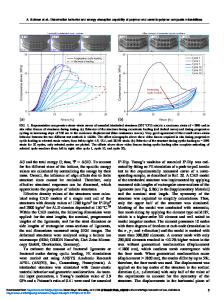Improvement of Specific Energy Absorption of Composite Tubular Absorbers using Various Stitching Pattern Designs
- PDF / 3,226,681 Bytes
- 22 Pages / 439.37 x 666.142 pts Page_size
- 71 Downloads / 255 Views
Improvement of Specific Energy Absorption of Composite Tubular Absorbers using Various Stitching Pattern Designs A. Rabiee1 · H. Ghasemnejad1 Received: 9 June 2020 / Accepted: 2 November 2020 © Springer Nature B.V. 2020
Abstract In this paper, various patterns of multi-stitched locations were studied experimentally and numerically to improve the specific energy absorption (SEA) in composite tubular absorbers. In this regard, stitching patterns with a horizontal distance of 3 mm, 6 mm, 9 mm and 18 mm in straight and zig-zag designs were investigated to justify their effect on mean crushing force and energy absorption capability. A multi-shell configuration finite element model is also developed based on energy-based contact definitions, which considers the delamination in Mode-I and stitching pattern design to accurately predict the energy absorption capability and axial crushing behaviour of composite crash absorbers, At stitched locations, the critical normal surface separation was utilised concerning experimental data to improve delamination resistance. The multi-stitching rows of 10–15-20–2530–35 mm with 3 mm horizontal and 2.5 mm vertical distances between each stitched point can increase the specific energy absorption up to 32% in comparison with nonstitched specimens. The developed numerical model for multi-layered composites absorbers in comparison with the existing methods is efficient in terms of accuracy with less than 5% error in comparison with experimental data. Keywords Energy absorption · Composites · Multi-stitching · Pattern · PARAM
1 Introduction In the past two decades, different types of crashworthy components were investigated including various geometrical shapes, material systems and lay-ups, various fabrication methods, trigger mechanism under oblique, axial, quasi-static and impact loading conditions [1–4]. However, the lack of through the thickness reinforcement can be a disadvantage in terms of mechanical performance, low interlaminar fracture toughness, impact damage resistance and crashworthiness behaviour [5]. There are several techniques to improve the mechanical properties and impact damage tolerance in the z-direction or through the thickness, and one of the most cost-effective reinforcing technique is through * H. Ghasemnejad [email protected] 1
Centre for Structures, Assembly and Intelligent Automation, Cranfield University, Bedforshire MK43 0AL, UK
13
Vol.:(0123456789)
Applied Composite Materials
the thickness stitching, which improves interlaminar strength and delamination resistance [6–8]. It has been shown that stitched reinforcement improves interlaminar fracture toughness and delays delamination crack propagation. Stitched specimens have shown a reduction of delamination within the damaged zone, which indicates an improvement of inelastic stretching of the tested material [9, 10]. Liu et al. [11] stated that increase of wall-thickness led to a significant increase in energy absorption, specific energy absorption and peak crush force. I
Data Loading...











